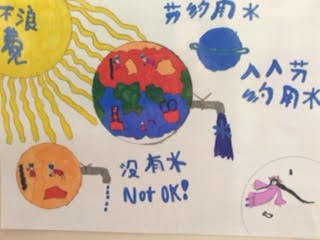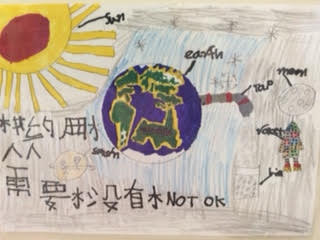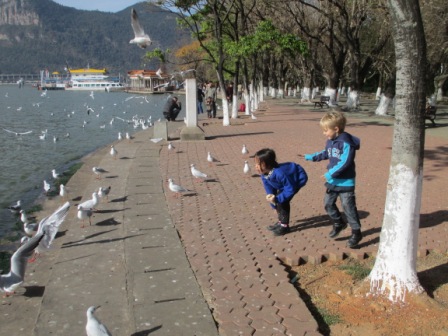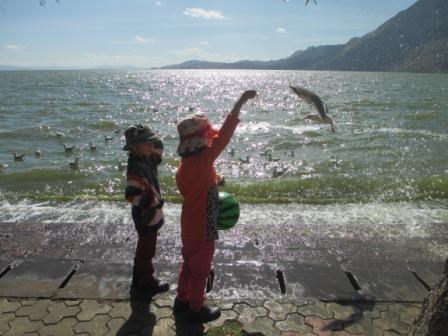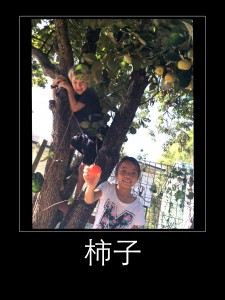- Conserve Water Poster by Aurora
- Conserve Water Poster by Lucas
We’ve been enjoying watching ‘Absolute Genius’, my kids especially loved this episode about Bazalgette’s genius sewer network idea in London at the time of ‘The Great Stink’. (The show is available on iView till 3rd May 2016). It’s a cool show that has two seemingly not so genius dudes, Dick and Dom that take genius ideas and look at them from scientific, technological, sociological and artistic perspectives. The genius idea springboards their own crazy idea, and they then seek help from modern day geniuses on how to get their idea to fruition. Each episode has spring boarded my kids into lots of research and their own experiments too. Kids find poo funny and intriguing, and watching crazy explosion poo experiments have enabled us to make lots of connections, eg. why are we putting an exhaust fan in our new downstairs toilet? If you want some Mandarin connections to ‘poo’ check out previous posts Primary School Toilet Humour and Tones and Doing a Poo guaranteed to get kids learning Mandarin!
But it’s actually 水 (shuǐ) WATER that all this has led us to…the curiosity of where our poo goes has led us to booking on an educational tour of our local sewerage treatment facility next week. And our research is leading us to understanding that it’s not just what we do in the toilet that goes through our sewers…it’s water from everything we do at home and industry. Water isn’t ‘made’, we only have what is on our planet. Our natural water cycle ensured we always had clean water…till populations and industry grew…then it needed some help so we didn’t all die of dirty polluted water!
- Haigeng Park, Lake Dian, Kunming
- Seagulls at Lake Dian, Kunming
Connections to personal experiences make learning so much deeper, and all this new learning has reminded us of a special place we used to visit when we stayed in Kunming, China a few years ago, called Haigeng Park on the edge of 滇池, Diānchí (Lake Dian). It was quite a surreal experience every time we visited, because on the one hand it is a place for locals and tourists to take in the beautiful vistas of the mountains and lake, on the other hand we were looking at one of the most polluted lakes in the world. Before 1990, 90 percent of Kunming’s wastewater was pumped untreated into the lake. The lake water is now undrinkable despite several billion dollars having been spent trying to clean it up. Some experts predict that over 55% of the lake’s fish population has been killed off by this disease ridden type of pollution. The water in the lake is rated grade V (the worst grade) which makes the water unfit for agricultural or industrial uses. We remember locals fishing there, and being told that the fish would end up at markets, and seeing workers in small boats their full time job to constantly pull out blue green algae . This experience has enabled us to have many discussions together and comparisons to how both China and Australia deal with water pollution. This new layer of experiences and knowledge is all part of a journey to understanding this problem of water pollution, which can be deceivingly, cleverly, often purposefully hidden from our view, but that we all need to understand and act on for our future sustainability. For more piks of our visits to Lake Dian you can check out the blog post Our Living The Chinese Way of Life Project
- 水 character art by Lucas
- 水 character art by Aurora
More Mandarin water connections… The kids made the posters at the top of this post to hang over our sinks to remind us about our precious water. They were inspired after learning Groovi Pauli’s song ‘Conserve Water’, which you can watch below! (see iTunes for his other great songs off his Green Album!). Lyrics to the song are underneath, just copy and paste them into word to enlarge if you want to do any art or write them on your own water awareness poster. A great technique used in the song and posters, are to write in ‘Chinglish’, and rhyme Chinese and English words together, helps the brain to remember vocab, in this case ‘没有水 NOT OK’ (shui rhymes with OK). Or you can download this Conserve Water Poster that we made to go with the song.
The character for water in Chinese is 水, and another great idea is to create visual art works around Chinese characters like the works above that my son and daughter did, to help visualise meaning of Chinese characters. If you would like to do this, copy the character and enlarge to print nice and big to draw your own imaginative water picture around it, or try and draw the character yourself as part of your picture.
All these poo and water connections because of an absolute genius called Bazalgette!
水,节约用水 shuǐ, jié yuē yòng shuǐ Water, conserve water.
水,节约用水 shuǐ, jié yuē yòng shuǐ Water, conserve water.
人人需要水 rén rén xū yào shuǐ Everyone needs water.
没有水not OK méi yǒu shuǐ Not OK Without water, it’s not OK
不要浪费水 bú yào làng fèi shuǐ Don’t waste water.
人人节约用水 rén rén jié yuē yòng shuǐ Everyone conserve water.
水,节约用水 shuǐ, jié yuē yòng shuǐ Water, conserve water.
水,节约用水 shuǐ, jié yuē yòng shuǐ Water, conserve water.
很多人没有水 hěn duō rén méi yǒu shu Many people don’t have water.
找水走很远 zhǎo shuǐ zǒu hěn yuǎn They walk far to find water.
有的水不干净 yǒu de shuǐ bù gān jìng Some water is not clean.
喝了会生病 hē le huì shēng bìng Drink it and become sick.
水,节约用水 shuǐ, jié yuē yòng shuǐ Water, conserve water.
水,节约用水 shuǐ, jié yuē yòng shuǐ Water, conserve water.
